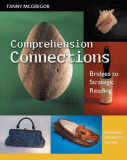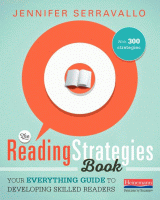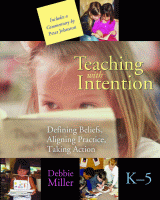In the early stages of my undergraduate teaching program, I was asked the question, “What are your beliefs about teaching and learning?”. I eagerly answered this question stating that I would be an engaging teacher who would make a memorable impact on students’ lives, especially with the use of music in the classroom (music is my “go-to” special skill). Although honorable, I did not quite understand then the depth of this question. Fast forward about 10 years of schooling and experience in the classroom, my teaching beliefs have a whole new meaning and understanding.
In my graduate studies, I was asked to focus my beliefs around reading instruction. I was encouraged to look beyond the safe answers of “engaging” and “fun” and really think about how these beliefs could drive my instruction and represent the outcome of what I wished my students would learn about reading. The idea of forming beliefs about reading instruction came from the book Teaching with Intention by Debbie Miller. This text was a large part of my study and development of my beliefs of teaching reading. Miller suggests you break up your belief statements into six categories: Classroom Environment, Classroom Culture, Understanding & Engagement, Lesson Design, Assessment, and Use of Time (Miller, 2008). I was asked to create my own belief statements similar to these categories, with a focus on reading instruction. Here are a few of mine:
I believe I can…Create reading environments that make a variety of texts available to help reach the goals and needs of students; making proficient readers who have the right to be engaged and accountable for their own reading.
There is no right or wrong way to create a literate classroom environment, as long as you are planning with your students in mind. You can sort by genre, subject, or any other category that makes sense for your collection. What is important is having a wide variety of texts that are of interest to your students and can provide windows and mirrors to the different demographics in your classroom. In addition to variety, create a classroom library that highlights texts and is inviting for students. “According to a recent study at the University of Salford, a well-designed classroom can boost student performance by 16 percent” (Cox). Some great classroom organization ideas I have seen are: having students help you organize your classroom library, displaying great titles that accompany your learning such as an author study or subject topic, or rotating books throughout the year to provide fresh/new titles for your students. No matter how you arrange your classroom, a true literate environment will reflect the intention and care you put into a collection that shows reading is a worthwhile activity that you truly believe in. “Classroom environments are organic-they grow as we do. The best of them reflect the hearts and souls of those who inhabit them” (Miller, 2008, p.42).
I believe I can….Guide and support students to find meaning in text using strategies where they use schema to build a foundation and gain confidence in their ability to comprehend.
Comprehension is big! Guiding and modeling the thought processes of reading is important to students’ understanding and development as readers. This goes beyond main idea, character, and setting, digging deeper into the relationship between reader and text. What is my brain thinking while I read? How does my own thinking help guide me through the features of different types of text? How am I synthesizing what I read? Tammy McGreggor offers some great ideas to represent concrete examples of this type of thinking in her book Comprehension Connections. McGreggor uses everyday items to represent the types of thinking our brain does while we read. I have found these concrete examples very helpful when introducing new comprehension concepts to developing readers. Once I introduced the idea of analyzing what our brains are thinking while we read, students were able to give a better idea of what they understand and their individual thought processes. “We’ve got to remember that it’s never a waste of time to teach kids to think. It bears repeating: beginnings matter.” (McGregor, 2007, p. 4)
I believe that….Reading instruction is the practice of intentional demonstration of reading with explicit explanation of strategies while engaging students to interact and use reading strategies to become proficient readers.
I believe that reading instruction involves intentional choices that demonstrate specific strategies used while reading. The Reading Strategies Book, by Jennifer Serravallo, is a great text to use to help guide this type of instruction. I successfully used this text with a guided reading group. This text provided me with the strategies in areas of need in each student, along with guiding anchor charts and prompts. Serravallo’s approach encompassed everything from fiction to nonfiction across all levels of reading, including strategies on development of reading and fluency to comprehension. This book provides a quick reference that can be used with little prep, to teach students about the processes of reading. Beyond teaching a set strategy each week, Serravallo’s strategies give the opportunity to explore the strengths and areas of improvement in individual students reading. I had candid conversations with my students about how these strategies are tools to guide them while reading. I also gave my students the choice to abandon a strategy that did not quite work for them, which in turn created a shift of responsibility as they were able to make decisions about their reading. “Strategies make the often-invisible work of reading actionable and visible” (Serravallo, 2015, p.8).
The alterations I made to my teaching beliefs helped me reflect on my instruction and my intention for my students. Teaching beliefs take time to create and can change as you grow and learn as an educator. I encourage you to challenge your own beliefs and see how they can complement your teaching. “We must meet children where they are, we must understand them well to teach them, and we must offer them the right amounts of supports and challenges to grow” (Serravallo, 2015, p. 19).
Ashley Gamlin M.S.
Classroom Specialist



References
Cox, J. (n.d.). Classroom Management for an Effective Learning Environment. Retrieved July, 2018, from http://www.teachhub.com/classroom-management-effective-learning-environment
McGregor, T. (2007) Comprehension Connections: Bridges to Strategic Reading. Portsmouth, NM: Heinemann.
Miller, D. (2008). Teaching with intention: Defining beliefs, aligning practice, taking action. Hawker Brownlow Education.
Serravallo, J. (2015). The reading strategies book: Your everything guide to developing skilled readers. Portsmouth, NH: Heinemann.
Pennington, M. (2018, July 6). Should We Teach Reading Comprehension Strategies? Retrieved July 17, 2018, from https://www.literacyworldwide.org/blog/literacy-daily/2018/07/06/should-we-teach-reading-comprehension-strategies






